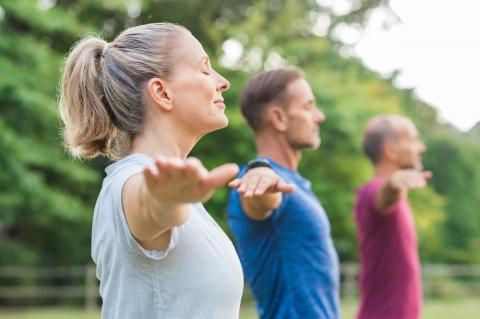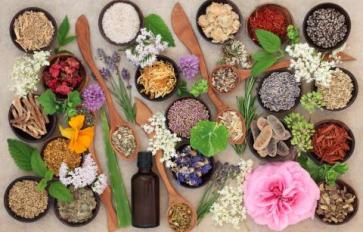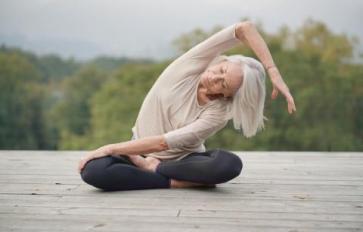
If sinusitis pain has become a common problem for you every time the weather turns, you may want to look towards yoga...
Remember the time you had the worst cold ever? And then the other times you seemed to have contracted a very virulent bug? Colds that don’t go away easy and come with crushing headaches or facial pain may be bouts of sinusitis. Sinusitis (or rhinosinusitis) is an inflammation of air-filled cavities within the bones around the nose. Called paranasal sinuses, these cavities usually contain mucus. When inflammation occurs, you start to feel a pressure and miserable pain that doesn’t seem to get better with anything. Plus, the more you try to blow your nose, the worse it gets.
Sinusitis Explained
Sinuses contain mucus, which keeps getting drained into your nasal cavity. It gets ejected when you blow your nose. So then new mucus is formed, needed to protect the delicate nasal cavity and keep it hydrated. If the sinuses get blocked and don’t drain into the nasal cavity, they become the perfect petri dish for bacteria to thrive in. Once you have an infection, the body’s immune system kicks in with a vengeance. The result: swelling and inflammation of these sinus cavities. This causes a headache and facial pain and conversely leads to even more mucus buildup. Ergo you get congested and then the body releases its soldiers—the white blood cells—to destroy this infection. This, in turn, thickens the mucus and often gives it a yellow or green tint. Basically, it turns into a vicious cycle, centered on pain and misery. The other symptoms of sinusitis are not any better either. Common ones include loss of smell or taste, persistent cough, bad breath, fever, toothaches, and a ringing or fullness in the ears.
What causes the sinus blockage could range from something as simple as a pollen allergy to medical reasons such as a deviated septum. Suffice to say, sinusitis can have a variety of environmental, anatomical, and genetic causes. Treatment ranges from surgery to medicines to even avoidance of certain allergens. Most doctors prescribe a course of antihistamines to bring down the inflammation. This then reduces the blockage, letting the mucus drain into the nasal passage. Other may prescribe a nasal spray to the same effect. The cure depends on the kind of sinusitis and the causal agent behind it.
Nasal Irrigation
The simplest and most basic chemical-free treatment that can ease a stuffed nose and painful face is a nasal irrigation. You can do this using a nasal bulb or syringe, or a neti pot—depending on what you feel comfortable with.
- Boil and cool clean potable water, and to each cup of water add 1/4 teaspoon salt and a pinch of baking soda. Once the salt has dissolved, fill up the container you are using.
- Lean a little forward towards your sink and tilt your head so that one nostril is pointing down.
- Breathe through your mouth. Now insert the tip of the neti pot or nasal bulb a little into the nostril that’s on top. Start pouring the saline.
- The saline will drain out through your other nostril, but some may enter your mouth. Spit it out but in case you end up swallowing a bit, no harm done.
- Once you use about 100ml of saline, stop and blow your nose to clear out the solution.
- Now tilt your head the other way to repeat the steps in the other nostril.
- Once it's done, clean all the items you have used in a gentle soap solution, rinse, and then air dry before storage.
Yoga To Relieve Sinusitis
There are many ways in which yoga can aid your quest to alleviate those sinusitis symptoms. Breathing exercises like the pranayama help to open the blockage and start draining out the mucus, thereby easing pain and pressure. And even standing or inversion poses help to boost the immune system, activate the lung meridians, and basically ease the respiratory tract by opening it out. Let us count the ways…
- Yoga Aids You In Breathing Right: Breathing exercises and breathing right is a basic premise that yoga is based upon. By breathing right—and deep—you increase the oxygen flow to all parts of the body—and oxygen is what is needed to heal all the damage in our body on a cellular level. One of the best pranayama to relieve sinusitis is Aulom Vilom. Studies have shown that nasal breathing exercises such as the pranayama help sinus sufferers reduce their symptoms by almost 50 to 70 percent. To perform: Sit in a cross-legged position with your back straight. Place your right index finger on the center of the forehead, right between the eyebrows. Exhale completely. Use your thumb to close the right nostril and inhale through the left nostril to a count of four. Hold to a count of 12-16, and then release the right nostril while blocking the left with the middle finger. Exhale through the right nostril to a count of four. Repeat 10 to 15 times, and adjust duration and count as per ease.
- Yoga Induces Relaxation: Pain makes you clench your teeth, and when you clench your jaw, it can further exacerbate headaches and facial aches. In effect, you are increasing pressure to an already under-pressure area. Yoga helps to relax all muscles and loosen all joints—so once you take that gritting off your jaw, you will feel a lightness in a splitting headache.
- You Sweat The Toxins Out: This doesn’t mean that one bout of yoga-induced sweating will make you free of that sinus attack, but science shows that sweating can rid the body of toxins rather effectively. If you perform yoga in a relatively heated room and keep drinking oodles of water while you sweat, you are helping your body to flush bad elements out. Regular yoga and exercise will help you prevent sinusitis flare-ups in the long run.
- Yoga Can Mate With Gravity To Dislodge Blockage: Inversion poses, such as the downward facing dog, Sarvangasana (shoulder stand) and Halasana (plow pose) can help to drain out the sinuses and sweep the upper respiratory tract with the help of gravity. Plus, these asanas also stimulate blood circulation, thereby reducing inflammation. Standing poses that involve waist twists and backbends can stimulate the chakras along the spine as well as the thoracic area. This, in turn, can increase circulation to the lungs and even add a boost to your body’s immune system.
- It Helps Increase Heart Rate & Blood Flow: All exercise, be it yoga or running or whatever you like doing, increases the heart rate. With an increased heart rate you get better blood flow and circulation, which in turn helps to distribute oxygen and antibodies to all parts of your body. Plus, endurance exercises have also been linked to a healthier white blood cell count in the body, the part of the blood that helps to fight off infections.
- Meditation Helps Ease The Pain: If you keep thinking about the pain you are in, you are likely to feel it even more. If instead, you start performing yoga or do a meditation session of 10-15 minutes, the mind tends to focus less on the pain and more on the picture you are painting for it. Meditation can take that edge off the pain, enough to make it bearable for you.
- All Exercise Releases Endorphins: Many studies have clearly shown that exercise helps the brain release endorphins, which are hormones that induce a feeling of goodwill, happiness, and harmony within us. So if through the pain, you feel a burst of sunshine from within, the pain lessens on its own.
We hope you can use these steps to help ward off any future sinusitis attacks or ease your symptoms if you are in the middle of one. If you have any tips to share with us, please do write to us in the comments section below. Remember, yoga is more a lifestyle practice and less of an exotic exercise routine…Namaste!








